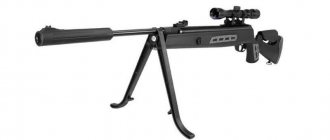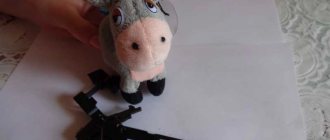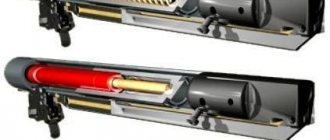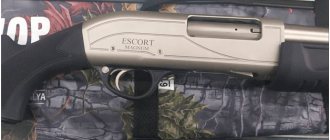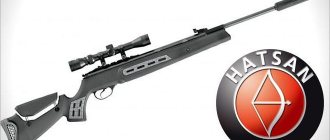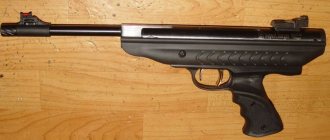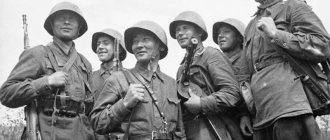Replacing the bypass on the Hatsan Striker Edge.
Shooting #Hatsan Striker Edge with and without bypass bushing.More details
Re-release of the new #Hatsan Striker Edge. Shooting with a chronograph.More details
Upgrading the HATSAN STRIKER EDGE air rifle!Read more
Replacing the piston cuff of Hatsan Alfa StrikerRead more
Hatsan. Where to get a pass if you don’t have a branded one. More details
Replacing the cuff on the Hatsan Striker Edge. Why shouldn't you use the original cuff? Sad experienceRead more
Replacing the cuff on the Hasan Striker Edge piston without disassembling the USM.Read more
TUNING HATSAN 125. REPLACING THE BYPASS CUFF SPRING AND SIGHT. I MADE A CANDY FROM MY AIR.Read more
How to disassemble Hatsan Striker Edge after 2022. Replacing the cuff, cleaning and lubricating the compressorRead more
Complete assembly/disassembly of Hatsan Striker Edge from 2022 onwards. from the mouth gas spring VD and cuff from GnoMRead more
Complete assembly/disassembly of Hatsan Striker Edge until 2022. from the mouth gas spring VD and cuff from GnoMRead more
how to install the bypass correctly;) Read more
HATSAN STRIKER EDGE, Test for penetration of the coil spring and GP, replacement of the cuff, bypass, installation of GPMore
Air Rifle Hatsan Striker EdgeRead More
Hatsan Striker Edge, replacing the coil spring on the GP, replacing the cuff, shooting through the chrono.Read more
Hatsan 125, installing a gas spring, replacing the cuff and barrel bypass.Read more
Hatsan 70, installing a gas spring, replacing the cuff and barrel seal.Read more
replacing the barrel bypass seal on a hatsan 125 hatsan 125More details
Source
Types of bullets for Hatsan 125
Now let's talk about what types of bullets there are for air rifles. Let's start with the simple and most familiar samples, and end with the “exotic” ones, which are suitable only for specific cases:
- Sharpened hunting bullets. Such cartridges most closely resemble the top of a Christmas tree and are intended for hunting various game. It is not very suitable as a training option, since it creases paper targets quite strongly and also leaves behind tears of varying sizes.
- Flat training bullets. A regular lead cartridge with a flat tip. When hitting a paper target, they leave behind very even holes, making the shooting practice process more effective. Very good for sighting sights.
- Rounded sniper bullets. When shooting at a distance of 100 meters or more from the target, a conventional bullet begins to behave unpredictably, as it begins to lose speed and also succumb to air resistance and wind. However, such a projectile with a rounded tip has better combat accuracy at long distances.
- Copper-plated bullets for pneumatics. An option for “lazy” owners who do not like the process of cleaning and lubricating weapons. Due to the fact that copper is much softer than steel, the barrel of a weapon experiences virtually no resistance at the moment of firing, which means that almost no carbon deposits remain. Also, such cartridges have a long shelf life.
- Armor-piercing bullets for pneumatics. The penetrating ability of this ballistic projectile is several times higher (4-6) than that of conventional hunting bullets, which makes them an ideal projectile for hunting game. However, due to their high mass, such cartridges are not suitable for every rifle, but only for powerful models.
- Expansive bullets for pneumatics. The penetrating power of this cartridge is significantly less than that of hunting ammunition, but when it hits a target it breaks into small pieces and has a lethal effect. Of course, it would be wise to use such a cartridge only for hunting.
- Flash bullets. If you are tired of boring rifle shooting, then you can buy this exotic cartridge, which is more like pyrotechnics. Bullets consist of a plastic shell filled with an explosive mixture. When fired, it detonates, so the shooter sees the bullet and also hears it.
There are also more unusual varieties of bullets, such as those with a brass tip, but most of them will not fit the Hatsan-125 rifle due to caliber or class (magnum). So let's look at the simpler options, and also decide which manufacturer's models are the best for this rifle.
Types of spring-piston rifles
Spring-piston air rifles can be divided into two types - with a broken barrel and those with a fixed barrel with an under-barrel or side cocking. The latter are very similar in principle of operation, although they have some differences.
"Hatsan 125" - 500 mm "Hatsan 135" - 450 mm "Hatsan 130" - 415 mm "Hatsan 130 QE" - 217 mm
For all these models, the manufacturer declares the same speed - 380 m/s. Yes, in reality, with heavy bullets weighing about 0.7 grams, optimal for “supers,” this figure is about 310 m/s, but this does not change the overall picture (see “Pneumatic bullet speed”).
But first, about the general structure (keep in mind that the spring itself can be either a classic coiled spring or a so-called “gas” spring - high or low pressure).
What is “overshoot” and how to deal with it :))
The bypass is a calibrated hole between the cylinder and the “chamber” . Its diameter, along with the characteristics of the spring, is of utmost importance. Thus, rifles sold in Russia by a number of companies, mainly the Spanish “Gamo”, as well as the peculiar Turkish gamo-clones “Hatsan Striker” / “AirTact” / “Alpha” (models from 2022), are weakened to the 7.5 joules required by law namely, a narrowed bypass (pictured below), and for the poaching, of course, illegal return of the original power (“ reinforcing the air ”), it is simply drilled out - just not with some “special drill” through the barrel. : for Gamo magnums on average up to 3.2 mm, for the above-listed Hatsans - up to 4 mm, or, as in the case of Diana 48/52/460, remove the washer.
Attention : the most interesting thing is that stupid drilling of the bypass in pursuit of increasing speeds after passing a certain optimal threshold (the same above-mentioned +/-3.2 mm for classic Gamov “magnums” with a 25x100 compressor) and even more so the removal of the bushing itself, on the contrary, will lead to deterioration (!) of characteristics. Well, it’s like trying to maximize the diameter of the jets on a Zhiguli carburetor in the hope of turning a VAZ into a Porsche :)). Eventually the engine will simply stop starting...
Here's the thing. If with a narrowed bypass it is intuitively clear, then with an “expanded” bypass everything is not so clear. With an optimal balance of compressor volume, mainspring force, bypass diameter and caliber, the bullet starts and moves along the barrel as the pressure increases, and its peak should be reached before it leaves the barrel - for maximum efficiency of the entire system as a whole. And with an overly expanded bypass, part of the air will be wasted: the analogy is with a firearm with a shortened barrel, where part of the powder charge designed for the standard length of the barrel bore simply does not have time to “burn out” while the bullet moves along the barrel, and a long sheaf of a useless sawn-off shotgun escaped from the barrel The flame is clearly visible at dusk.
Characteristics of Hatsan Striker Age
| Type of air gun | Spring-piston or gas spring |
| Rifle caliber | 4.5 mm |
| Initial bullet speed | 305 m/s. |
| Overall length of the rifle | 1 meter 100 centimeters. |
| Barrel length | 45.0 cm |
| Barrel type | threaded. Charging capacity - single-charge type. |
| Main energy source | spring. |
| Magazine capacity | 1 lead bullet |
| Sight Features | front sight with adjustable or fiberglass threads |
| Optical device fixation type | dovetail - base 11 mm. |
| Type of sighting equipment | sighting sight and bar |
| Rifle weight | 2,900 kg. |
| Platoon unit type | trunk fracture |
| Butt material | plastic |
| Manufacturer | Türkiye |
Air rifles with a broken barrel
About them quite briefly, since this type is widely known from the Soviet Tirov “ovens”. Although recently, even in such a conservative segment as spring-piston “fractures”, completely unique designs have also emerged. Some of them are described in the article “Unusual pneumatics: two calibers in one rifle.”
The actual loading process looks very simple: we break the barrel, the cocking rod moves the piston in the cylinder until it is cocked, held by a hook. Then we insert the bullet and return the barrel to its working position.
Pay attention to your left hand. If you neglect the retention, then if the piston is likely to fall off the hook, it is quite possible to get a broken coupling, the so-called “banana”, that is, a barrel bent upward (photo below), in especially sad cases, even with this same barrel on the forehead.
For example, the force of a heavy-duty spring may not correspond to the bypass characteristics or even the caliber of an airgun (see “Powerful Airguns: Hatsan mod 135”). The result is an unbalanced rifle with terrible accuracy and, funnily enough, reduced bullet velocity. Or, if the design of the fracture unit is unsuccessful, the bypass seal - a rubber or polymer ring on the end of the cylinder or barrel coupling (pictured below) - may become jammed or even cut off when closing.
In the above photograph, a detail is clearly visible that characterizes one of the fundamental differences in the barrel locking design of break rifles - a spring-loaded ball through a tooth. The second option is a spring-loaded bolt (in the photo below - under the barrel in the coupling) through a transverse pin or a fixed bolt.
If the sharpening angles of the bolt are unsuccessful, breaking and locking the barrel requires too much effort. Or the barrel, on the contrary, is poorly kept in a locked state. It’s these kinds of “little things” that often plague the designs of spring-piston pneumatics in the budget segment.
Shooting
Before moving on to choosing bullets, you first need to understand how to properly zero an airgun. The fact is that many beginners perform this procedure completely incorrectly, after which they begin to complain that certain ammunition has poor accuracy or their barrel is defective. To prevent such thoughts from arising in you, it is necessary to carry out shooting according to a certain algorithm of actions:
- We are re-preserving the rifle. Yes, just buying a weapon and installing optics on it is not the best idea. You must first get rid of the factory silicone grease using special alkaline compounds, and then carry out thorough cleaning, rinsing and lubrication. Only after applying a high-quality mineral composition will the weapon be ready for zeroing, and the likelihood of a ballistic projectile deflecting to the side will be minimized.
- We choose a place and time for shooting. It is best to shoot a weapon indoors, where the bullet is not affected by various weather conditions (wind speed, air humidity, and so on). However, if going to the shooting range is impossible, then it would be better to wait for a sunny and windless day, and only then go outside with a rifle. It is also worth choosing a flat place without any landscape obstacles.
- We create a comfortable position. If you have a machine for securing a rifle, then you are very lucky. If not, you will have to get several bags to secure the barrel (just fill a pillowcase or a sandbag). It is also necessary to choose a comfortable position for shooting, so that nothing interferes and the muscles are at rest. In general, your task is to ensure that the barrel is in a static position during aiming, otherwise the zeroing will not show a normal result.
- Let's start shooting. It is best to choose the bottom of the target as your zeroing point, as it is the easiest to aim at. We fire three test shots, after which we look at the spread of bullets. If it turns out to be minimal, then the position has been chosen correctly and you can begin adjusting the sighting device. If the spread is very large (more than 1 centimeter when shooting from 10 meters), then you should change the position or still think about going to a shooting range where there is a fixing machine.
- We adjust an open or optical sight. For this purpose, the device is usually equipped with two drums that regulate the vertical and horizontal. If we are talking about a collimator or optics, you will first have to remove the protective caps from the parts. Each click of the drum indicates that the aiming bar or lens has moved 1 millimeter to the side. We adjust the sight in the desired direction and fire three more shots at the same target. And so on until the weapon hits the target exactly.
So what is all this detailed description for? In order to select the most suitable ballistic projectile for a particular case. For example, for sniper shooting with a telescopic sight, it is better to use rounded bullets, since they have good ergonomics. And if you plan to take the Hatsan-125 hunting, you will have to use sharpened ballistic projectiles. However, different bullets do not behave the same way. So you can experiment with different cartridges to find the ones that have the best balance between accuracy and penetration.
